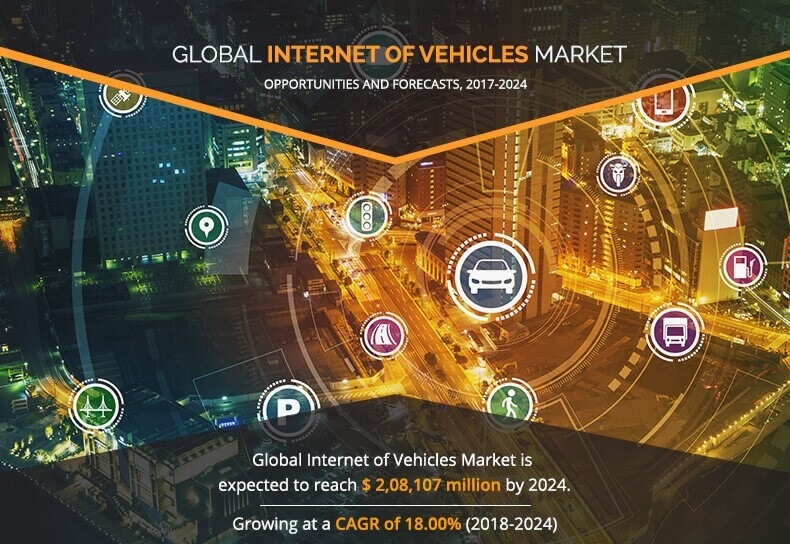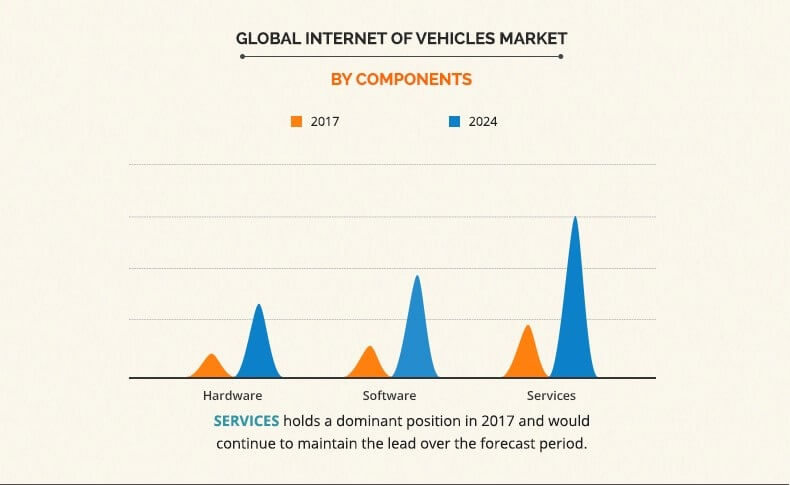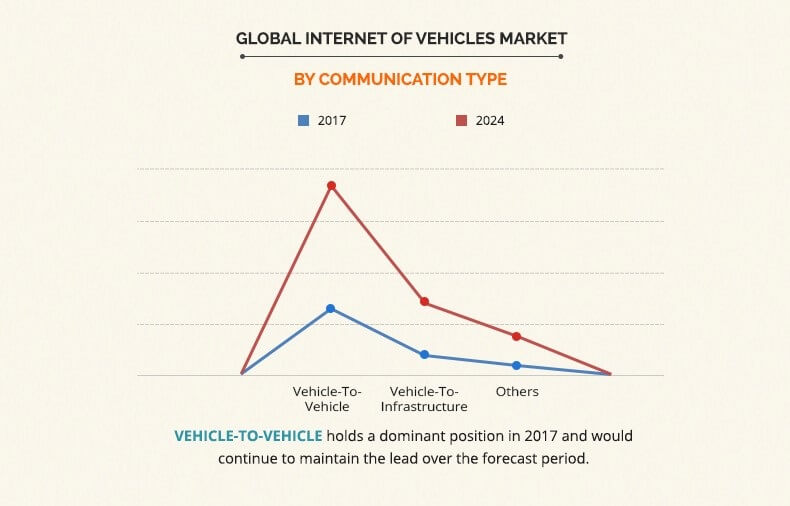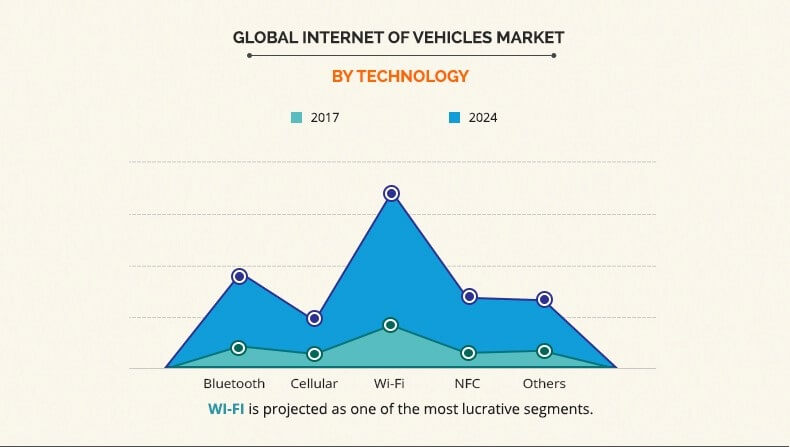Internet of Vehicle Market Outlook: 2024
Internet of Vehicles (IoV) helps a vehicle to connect to the nearby vehicle or other traffic infrastructure using a wireless network. Through this technology the vehicles send floating data to the base area located at long distances. It helps the user to locate the vehicle as well as the ones around. In addition to it, the vehicles detect the speed and distance of the nearby vehicle and manage self-speed accordingly. The global internet of vehicles market was valued at $66,075 million in 2017, and is projected to reach at $208,107 million by 2024, growing at a CAGR of 18.00% from 2018 to 2024.
The increased demand for GID, which is a prominent part of internet of vehicle market, is on a significant rise due to the security of the vehicle and safety issues which drives the growth of the internet of vehicle market.
The Wi-Fi segment led the market in 2017 and is expected to remain dominant in future. Furthermore, the vehicle-to vehicle communication segment dominated the overall internet of vehicle market share in the same year.
Global Internet of Vehicles Market
Increase in demand for vehicle tracking and driver safety and surge in adoption of IoT and cloud services are the major factors that fuel the growth of the internet of vehicle market. However, factors such as inefficiency in determining the exact vehicle position and loss of data due to obstacles such as landscapes hamper the market growth to a certain extent.
The report focuses on the growth prospects and restraints of the market based on the analysis of regional trends. The Porters five forces analysis of the industry helps understand the impact of various factors such as bargaining power of suppliers, competitive intensity of competitors, threat of new entrants, threat of substitutes, and bargaining power of buyers on the internet of vehicle market growth.
Global Internet of Vehicles Market By Components
Segment Review
The global internet of vehicles market is segmented into component, technology, communication type and region. Based on component, it is divided into hardware, software, and service. Based on technology, it is classified into Bluetooth, cellular, Wi-Fi, NFC, and others. By communication type, it is categorized into vehicle-to-vehicle, vehicle-to-infrastructure, and others. By region, it is analyzed across North America, Europe, Asia-Pacific, and LAMEA.
Global Internet of Vehicles Market By Communication Type
The key players operating in the global internet of vehicles market include Ford Motor Co., Texas Instruments Inc., Audi AG, Intel Corporation, SAP, NXP semiconductors, Apple Inc., Google Inc., IBM Corporation, and Cisco Systems Inc.
Global Internet of Vehicles Market By Technology
Top Impacting Factors
Factors such as rising internet penetration, growth associated with connected devices, increase in presence of automation solutions in automotive industry, introduction of Logistics4.0, drive the internet of vehicle market growth. However, inefficiency in determining the exact vehicle position and loss of floating data due to obstacles are expected to hamper the market growth during the forecast period.
Penetration of IoT and Cloud Services
Many organizations and personal user are adopting internet of vehicles, as it helps them to track fleet, trains, buses, and cars. IoV uses the sensors and presently available mobile phones and other gadgets to further the mobility of. In addition, the moving vehicles transmit a lot of information while travelling and cloud services provide the required platform. This in turn boosts the adoption of internet of vehicle.
Emergence of Global Identification (GID)
A vehicular GID is a communication gateway and is integrated with the global universal network connectivity. It is a smart in-vehicle sensor that provides global positioning, online identification of the vehicle, and the name of its owner. It acts as a virtual license plate of the vehicle. GID increases the usability of IoV; thus, fueling the market growth.
Automated Functions
The future of IoV lies in the automation of vehicles. With the advancement of technology, the vehicles are geared up to slow down the speed after avoiding the warnings, on detection of any vehicle nearby and further, if necessary apply brakes or turn the wheels. The next generation of IoV would see a fully automated driver car.
Key Benefits for Stakeholders
- This study includes the analytical depiction of the global internet of vehicles market along with the current trends and future estimations to determine the imminent investment pockets.
- The report presents information related to key drivers, restraints, and opportunities.
- The current market is quantitatively analyzed from 2017 to 2024 to highlight the financial competency of the industry.
- Porters five forces analysis illustrates the potency of buyers & suppliers in the global internet of vehicles industry.
Internet of Vehicle Market Report Highlights
| Aspects | Details |
| By Component |
|
| By Technology |
|
| By Communication Type |
|
| By Geography |
|
| Key Market Players | IBM CORPORATION, GOOGLE INC., CISCO SYSTEMS INC., NXP SEMICONDUCTORS N.V., APPLE INC., INTEL CORPORATION, FORD MOTOR COMPANY, AUDI AG, SAP, TEXAS INSTRUMENTS INC. |
Analyst Review
Internet of vehicles uses hardware and software automation, and incorporation of various technologies. The internet of vehicle market is expected to witness an increase in demand for road safety and rise in adoption of IoT in vehicles. This technology helps vehicles to connect to adjacent vehicles or other traffic infrastructure in the field of wireless network. Using this technology, vehicles can send floating data to the base station situated at any location. In addition, it helps users to locate vehicles as well as in the nearby area. Some of the examples of communication types include vehicle-to-vehicle, vehicle-to-infrastructure, and others.
Periodic launches of new and improved technologies and progressive enhancement from manual cognitive for automated cognitive fuel the market growth. Innovations in GID has improved security and increased opportunities in the global internet of vehicle market. Furthermore, introduction of 5G technology and incorporation of this technology with IoV ensure that floating data is transmitted efficiently and reduce the chances of data loss. These factors are expected to boost the growth of the market.
In 2017, North America was the highest contributor, in terms of revenue, in the internet of vehicle market. In addition, vehicle-to-infrastructure segment has contributed significantly to the revenue to the market in North America. Furthermore, Wi-Fi technology segment is anticipated to witness the highest growth rate during the forecast period, due to heavy investment across developing nations.
Prominent players have adopted various strategies, such as new product launch, business expansion, and strategic alliances to increase awareness about mining automation across various countries to strengthen their position and enhance the internet of vehicle market share.
For instance, Fiat Chrysler Automobiles (FCA) collaborated with Waymo, a leading a self-driving technology company in 2016, to launch fully automated driving cars. In addition, FCA joined forces with BMW Group, Intel Corporation, and Mobileye, an Intel company in July 2016 to develop self-driving vehicles by collaborating to bring solutions for highly automated driving (Level 3) and fully automated driving (Level 4/5) into production by 2021.
Loading Table Of Content...







